Sam Peckinpah’s final western: Pat Garrett and Billy the Kid (1973)
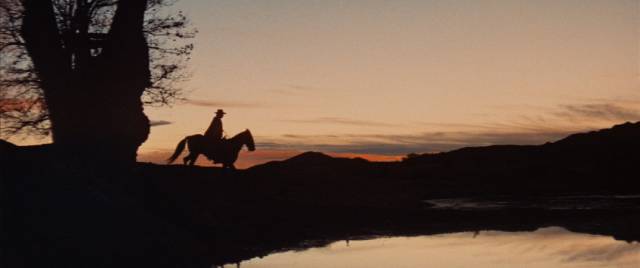
Sam Peckinpah was a fascinating figure – an unquestionably talented filmmaker whose personal demons frequently brought him into conflict with producers and studio executives, resulting in a number of compromised productions. His stubbornness and perfectionism often sent him over-schedule and over-budget and, while commercial success might prove him right, backers were wary of putting their trust in him. This pattern was forged early in his career; after several years directing episodic television and a couple of modest features (The Deadly Companions [1961] and Ride the High Country [1962]), he embarked on an ambitious epic which so unsettled his backers that it was eventually taken away from him and so clumsily cut by the producers that it now stands as a tantalizing signpost towards Peckinpah’s greatest success, an exemplar of failed promise and an early marker for the enduring conflicts between ambitious auteurs and money-men which perhaps reached their zenith with Michael Cimino’s Heaven’s Gate (1980).
The rocky experience of Major Dundee (1965), quickly followed by Peckinpah’s removal from The Cincinnati Kid (also 1965), stalled his career for several years. His only significant work during this fallow period was the one-hour television drama Noon Wine (1966), but he emerged from the wilderness with what would be his biggest commercial and critical success, the hugely influential The Wild Bunch (1969). That success gave him the impetus for his busiest and most creative period – he made four features over the next three years, each very different in subject and tone. After the epic violence of The Wild Bunch, he made the leisurely, elegiac The Ballad of Cable Hogue (1970), which transformed his lament for the end of the West under pressure from encroaching modernism into a raunchy comedy.
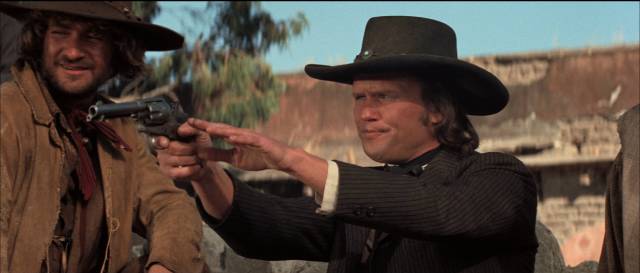
That was followed by the brilliant but controversial Straw Dogs (1971), which in turn gave way to Junior Bonner (1972), another elegiac lament for the end of the frontier, now set in the present after the values of the West had long been swept away by Capitalism. The surprising gentleness of this character study gave way in turn to the harsh, cynical violence of The Getaway (also 1972); adapted from a Jim Thompson novel, its jaundiced view of a world driven by nothing but the pursuit of money ended with a vision of the United States as a vast garbage dump.
And then came Pat Garrett and Billy the Kid (1973), perhaps the most problematic movie of Peckinpah’s career. His disgust with the present, openly on display in The Getaway, sent him back to the West for what was no doubt intended to be his definitive statement about what he felt had been lost when the frontier was subjugated by “civilization” – the latter being little more than money and political corruption in the service of wealth accumulation. More than Major Dundee, Pat Garrett became something like the defining debacle of Peckinpah’s career, a movie which essentially remains unfinished though multiple versions now exist. I have five different cuts on disk – the 2005 Warner special edition DVD includes the “Turner preview version” discovered in 1988 as well as a revised cut which merged that version with the original theatrical release (not included in the set); and now Criterion’s new restoration includes the theatrical cut, a “50th Anniversary release” which further tweaks the 2005 cut, and the final preview version, which varies slightly from the 1988 Turner version.
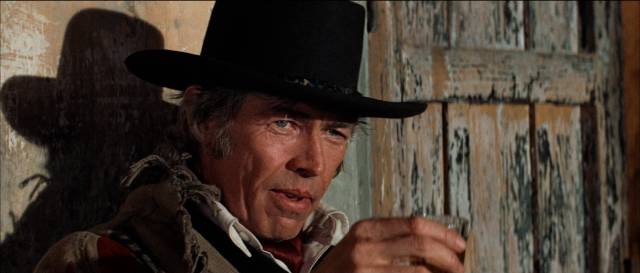
The reason for all this is that Peckinpah never actually finished the film. He delivered the final preview cut under pressure from the studio to rush completion and then walked away (he wasn’t kicked off the production, as has sometimes been asserted, but quit), leaving his editors to create what the studio considered a releasable version. Peckinpah’s actions were the culmination of problems which had plagued the production from the start. That story began long before Peckinpah entered the scene.
In a brief but fascinating introduction to the published script (Signet, 1973), writer Rudy Wurlitzer offers an account of what, from his perspective, was a bastardization of his original intentions. He wrote his first draft after being approached by a producer, an existential meditation on the death of freedom on the frontier, with Billy the Kid posing an obstacle to “progress”, told to leave New Mexico or be eliminated, and choosing to stay because a violent end was essential to his self-mythology. But Wurlitzer’s main interest was actually in Garrett, a man who sells out his own principles because he wants some kind of security and, more importantly, just to go on living; it’s about “Garrett’s decision to sell out in order to survive, to live rather than die, to abandon obsolete descriptions of courage and freedom for a more complicated if more corrupt sense of order”. In that draft, Billy and Garrett never meet until the moment in which the latter kills the former.
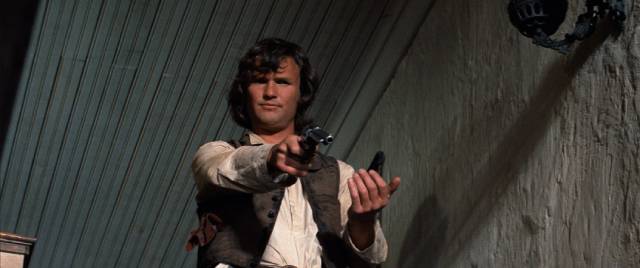
There followed several years of typical development hell. Stars and directors came and went, demanding various changes to accommodate their own interests. What was needed was more action, more ticket-selling set-pieces. Then, finally, having moved on, Wurlitzer was called back because Peckinpah had been hired. In his brief account, the writer is hardly complimentary about the director, who bent the rewrite towards what Wurlitzer considered cliches and macho posturing. (Wurlitzer doesn’t mention Peckinpah by name, but says “A new director appeared, a director famous for one spectacular western and even more famous for his tantrums, rages, macho passions, and banal, highly embarrassing pronouncements.”) Ditching the parallel structure which leads to the fatal confrontation, Peckinpah insisted that Pat and Billy needed to be established as old friends from the start, that what had begun as a meditation on historical forces should become the story of a friendship corrupted by circumstance.
What’s interesting here is that Peckinpah found an echo of his own theme in Wurlitzer’s script, his long-standing lament about the inevitable end of personal freedom in the face of “progress”. In fact, in the movie as it finally emerged Billy and Garrett are analogues for Pike Bishop and Deke Thornton in The Wild Bunch, old friends who have made opposite choices, for whom survival means abandoning principle while holding onto integrity inevitably leads to a violent death. Embodying this theme in this particular story, though, leads to romanticizing Billy, a murderous sociopath presented as a charming free spirit given to the casual, off-hand killing of anyone he finds inconvenient.
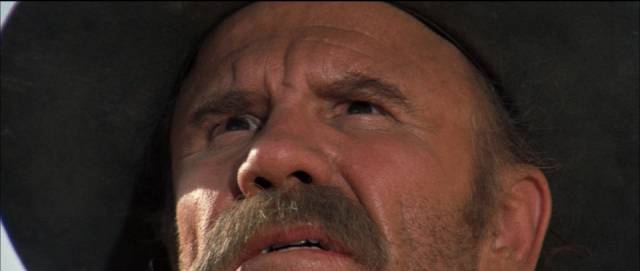
Casting is crucial to obscuring the underlying problem here and Peckinpah’s choices are seemingly counter-intuitive. To reinforce the idea that Billy is an authentic folk hero, a 19th Century “rock star”, Peckinpah hired Kris Kristofferson, a successful song-writer and singer with limited acting experience (a couple of supporting roles and the lead in Cisco Pike [1971], a low-budget post-Easy Rider movie about a drug dealer). Kristofferson has easy-going charm, but he lacks the lean menace you’d expect from Billy the Kid. There’s something disconcerting about his laid-back way of killing people; are we expected to side with him just because he’s the cool anti-hero? While shooting the obnoxious religious fanatic deputy Bob Ollinger (R.G. Armstrong) seems deserved, shooting the likeable deputy Bell (Matt Clark) in the back should call into question where viewer sympathy lies. The undeniable likeability of Kristofferson obscures a central problem with the film’s thematic dichotomy; the principle of freedom and independence, supposedly a core characteristic of Peckinpah’s vision of the West, is embodied by a cold-blooded killer. The historically inappropriate casting of Kristofferson, in fact, appears to be a deliberate attempt to produce this obscurity.
There’s an odd weightlessness to this Billy which, perhaps inadvertently, causes our sympathy to shift to Garrett, in accord with Wurlitzer’s original conception. As embodied by James Coburn, the sheriff carries a weary melancholy as circumstances have brought him to the point of having to do something completely at odds with his own feelings and beliefs. He is openly contemptuous of the powerful men who have tasked him with eliminating Billy because figures like the Kid jeopardize their expanding business interests – the rancher Chisum (Barry Sullivan), Governor Wallace (Jason Robards), political operatives Howland (Jack Dodson) and Norris (John Davis Chandler) – and he’s sincere about wanting Billy to leave the territory so that he can avoid killing him.
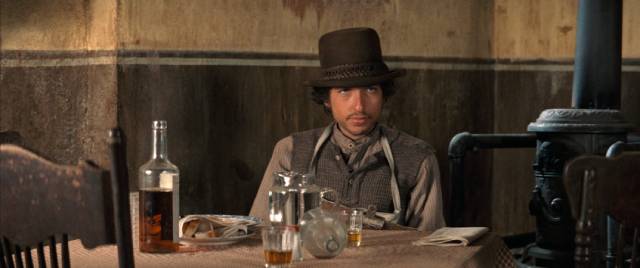
It’s Garrett’s reluctance to carry out the task he’s been assigned which gives the film its unconventional narrative structure; while Billy never strays far from Fort Sumner and Garrett knows that this is his base, the sheriff wanders around the territory for weeks ostensibly seeking information about Billy’s whereabouts. This quest is bogus; he’s wasting time to avoid the inevitable. But it permits Peckinpah to create a series of self-contained sequences, each of which evokes his conflicted feelings about the disappearance of the old West. Rather than a focused dramatic narrative, Pat Garrett is a leisurely picaresque comprising a series of vivid moments through which the two protagonists pass on their way towards a downbeat destiny.
The production itself was fraught with problems. The shoot involved a gruelling five months on location in Durango, Mexico, with cast and crew frequently sick and equipment not working. If this wasn’t enough cause for stress, Peckinpah was sinking deeper into alcoholism, reputedly functional for only a few hours a day. Leaning into this, the production placed a “joke” piece in the trade papers back in Hollywood confirming that he was indeed drunk all the time, with a photo of him on set on a stretcher at the end of a tube attached to a whisky bottle.
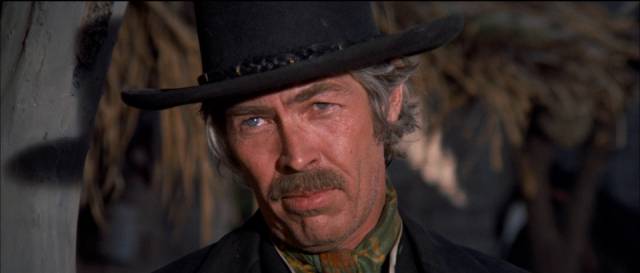
And yet, despite Peckinpah’s self-destructive behaviour, each individual scene in the film is beautifully directed – and gorgeously shot by Dutch-born, U.K.-based cinematographer John Coquillon, who had first worked with Peckinpah on Straw Dogs, and went on to shoot Cross of Iron (1977) and The Osterman Weekend (1983). The sense of period, the elegiac mood, the air of sad resignation in the face of unwanted change are all rendered with precision and formidable self-assurance. This is perhaps as much a tribute to the cast and crew’s loyalty to their director as it is to Peckinpah’s innate talent. Fittingly, the large cast is an encyclopedic collection of character actors who together embody the history of the western. While the structure means many of these familiar faces appear for only one or two scenes each, they bring with them so much history that the film is imbued with layers and textures which deepen the narrative in ways the script alone might not have achieved.
In addition to Coburn, Kristofferson, Armstrong, Robards and Sullivan, indelible impressions are made by Chill Wills, Luke Askew, Richard Bright, Jack Elam, Emilio Fernandez, L.Q. Jones, Charles Martin Smith, Harry Dean Stanton, John Beck, Elisha Cook Jr., Gene Evans, Dub Taylor… and in what may be the film’s signature sequence, Katy Jurado and Slim Pickens, in which the latter’s senseless death evokes an unbearable feeling of loss. In this brief moment, Peckinpah undermines the entire ethos of the genre in which violence is seen as the essential cathartic solution to all problems.
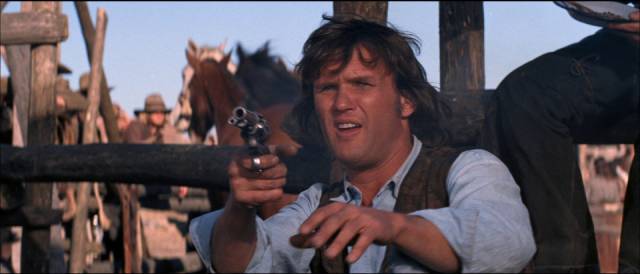
Ironically, Peckinpah actually disliked the one element of this sequence which has fixed it so firmly in pop culture memory. As Jurado and Pickens wait at the edge of the river for his death, Bob Dylan’s “Knocking on Heaven’s Door” plays on the soundtrack. In a way, I agree with Peckinpah – the song somewhat gilds the lily, putting into explicit words what the images have already conveyed so eloquently, sentimentalizing something which is already unbearably poignant. And yet the scene and the music are almost unimaginable without each other – the song’s absence in the preview cut is disorienting.
Which brings us to the single most unexpected thing about Pat Garrett and Billy the Kid; the presence of Bob Dylan, not only on the soundtrack but also on screen. Even more than Kristofferson, Dylan’s presence links the outlaws to contemporary stars, while his music blends traditional and modern styles effectively, giving the film the tone of a folk ballad in much the same way Leonard Cohen’s music worked in Robert Altman’s McCabe & Mrs. Miller (1971). The presence of Dylan on-screen adds an enigmatic note – early in the film, when Garrett notices him and asks “who are you?”, he replies “that’s a good question”. His character was not in the original script and no one, it seemed, actually knew what his role was. Later, when asked his name, he replies “Alias”. Asked “Alias what?”, he says “Alias whatever you please.” And yet, he has enormous screen presence, every little twitch of his features, every gesture, suggesting some significance which is just beyond our grasp. Tagging along with Billy after his escape from jail, Alias comes to serve as the audience’s substitute, a sharp-eyed observer of the slow, inevitable journey towards the moment of death, while Dylan’s music and lyrics act like a Greek chorus commenting on the inescapable fate which binds Billy and Garrett to one another. Dylan’s presence gives the film a kind of post-modern, self-referential quality, a built-in deconstruction of its own genre which makes it unlike Peckinpah’s other westerns, although in retrospect they can be seen to be working towards this.
*
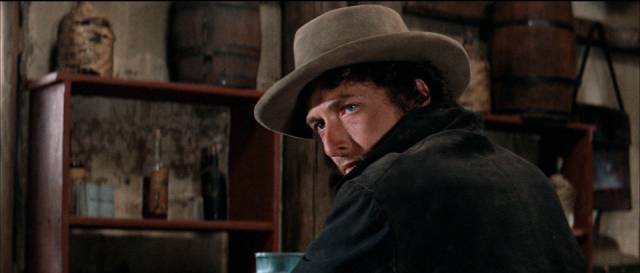
If this process ultimately falls short of being fully realized, that may be because Peckinpah walked away – but it may also be because he was feeling his way towards it as he shot the film and never managed to fully form his intentions. As it stands, in all its variants, Pat Garrett and Billy the Kid is not entirely successful, but it’s nonetheless the richest of his westerns; not entirely satisfying as a whole, but moment by moment enormously rewarding.
A commercial and critical failure when first released, it has grown in stature through each subsequent iteration. It seems obvious now that its original failure was due to the producers’ efforts to turn the film into a conventional narrative when what Peckinpah had shot couldn’t work that way. Though it’s hard to pinpoint you can sense that there’s something missing from the theatrical cut; scenes feel rushed and strung together almost arbitrarily, trying to get to some narrative point which never arrives in a satisfying way. Although the preview cut is only sixteen minutes longer, its rhythms are different; it breathes and opens spaces for those enigmatic moments which, though they might seem narratively unnecessary, are actually the film’s raison d’etre.
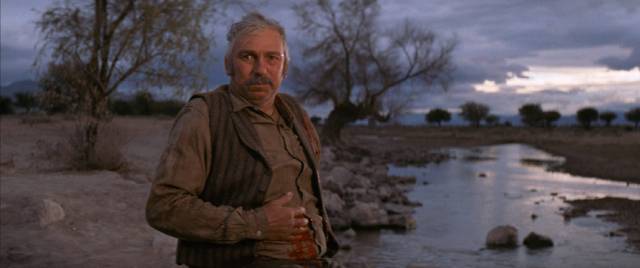
It’s no doubt in recognition of this that the 50th anniversary cut supervised by Paul Seydor and Roger Spottiswoode (the latter one of the original editors) is quite close to Peckinpah’s final preview cut, tightened up a little, with some rough edges smoothed out. It restores the prologue with Garrett being assassinated decades after killing Billy, ordered by the same business interests which had hired him back then (though it drops the reprise of this sequence with which the preview cut ends), as well as the lengthy text epilogue in which Peckinpah spelled out the corruption of those men who ruined the West. The biggest improvement with the new cut is in the visual quality, scanned in 4K from the negative, while the preview cut was scanned in 2K from the uncorrected print which managed to survive because Peckinpah had his assistant Chalo Gonzalez steal it from the projection booth.
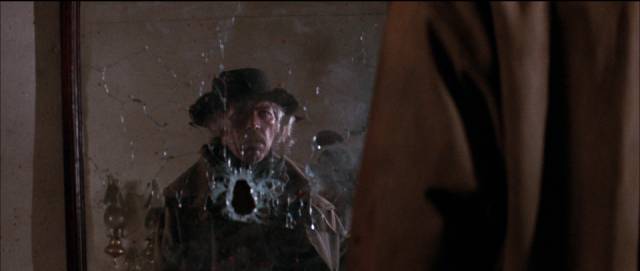
As comprehensive as Criterion’s two-disk release is, Pat Garrett and Billy the Kid remains something of a puzzle with a few pieces still missing, but it nonetheless illuminates Peckinpah’s abilities and interests in ways which are perhaps not quite so clear in some of his more finished movies.
In addition, the disks include a new commentary on the 50th anniversary cut, an interview with writer Clinton Heylin on the soundtrack and Dylan’s role in the film, an archival television interview with Coburn by critic Charles Champlin from 1988 which addresses the discovery of the Turner preview cut, and a new episode of Mike Siegel’s on-going documentary about Peckinpah’s work, Passion & Poetry: Peckinpah’s Last Western.
*
I was in the middle of writing this when news came that Kris Kristofferson had died on September 28, at the age of 88. Already a successful singer and song-writer when he was cast as Billy, he maintained his musical career while accumulating well over a hundred acting credits over fifty-odd years in a wide range of movies, including two more with Peckinpah; a small role in Bring Me the Head of Alfredo Garcia (1974) and the lead in Convoy (1978).
Comments
Spot on observations on the various cuts. My favorite is still the 1988 preview version.
I might agree, though I do miss “Knockin’ on Heaven’s Door”.